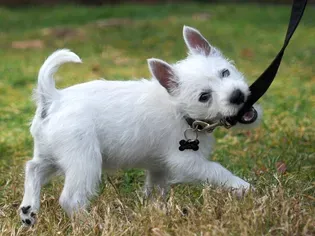How to Leash Train Your Puppy
Updated on 04/26/24

Unleashing the Joy of Leash-Trained Puppies: A Comprehensive Guide
Embark on an adventure with your furry companion by mastering the art of leash training. This essential skill not only enhances your bond but also ensures the safety and well-being of your beloved puppy. Join us as we delve into a comprehensive guide that will transform your pup into a well-behaved and confident leash walker.
Why Leash Train Your Puppy?
The benefits of leash training extend far beyond confined walks. It instills discipline, strengthens trust, and opens up a world of outdoor adventures. Here are compelling reasons to embark on this crucial journey:
* Control and Safety: Leash training provides a secure connection between you and your puppy, ensuring their safety in unfamiliar or potentially dangerous environments.
* Behavior Modification: Leashes deter unwanted behavior, prevent pulling, and promote obedience, shaping your puppy into a responsible canine citizen.
* Bonding Experience: Leash walks offer ample opportunities for bonding and interaction, strengthening the unbreakable bond between you and your furry friend.
* Exercise and Enrichment: Outdoor walks provide physical and mental stimulation, keeping your puppy active, healthy, and intellectually engaged.
* Socialization: Leash-trained puppies can safely interact with other dogs and people, fostering socialization skills and building confidence.
Equipment Essentials
Before embarking on this training adventure, gather the following essential equipment:
* Leash: Invest in a high-quality leash that is the appropriate size for your puppy. Avoid retractable leashes as they can reinforce pulling behavior.
* Collar or Harness: Choose a comfortable collar or harness that fits snugly but not too tightly. Avoid using choke chains or prong collars as they can cause discomfort or injury.
* Treats: High-value treats are essential for positive reinforcement and motivation. Consider small pieces of cooked chicken, cheese, or other irresistible treats.
Step-by-Step Leash Training
1. Introduction:
* Start in a quiet and controlled environment, such as your living room or backyard.
* Attach the leash to your puppy's collar or harness and let them sniff and explore it.
* Reward them with a treat for remaining calm and curious.
2. Gentle Pressure:
* Gently apply tension to the leash, encouraging your puppy to move in the direction you want.
* Avoid pulling or jerking the leash as it can damage their neck or create fear.
* If your puppy resists, stop applying pressure and redirect them with a treat.
3. Teach the "Heel" Command:
* Hold the leash in your left hand and a treat in your right.
* Command "heel" and walk in the desired direction while guiding your puppy with the leash and treat.
* Repeat this exercise until your puppy consistently walks beside you without pulling.
4. Loose Leash Walking:
* Gradually increase the distance and distractions your puppy is exposed to.
* Reward them for walking on a loose leash, avoiding tension or pulling.
* Practice in various environments, including parks, sidewalks, and busy streets.
5. Common Challenges and Troubleshooting:
Pulling:
* Remain calm and avoid jerking the leash.
* Stop walking and redirect your puppy's attention with a treat.
* Practice loose leash walking in controlled environments before progressing to more challenging situations.
Fear and Anxiety:
* Identify the triggers that cause your puppy's fear or anxiety.
* Start training in a safe and comfortable environment and gradually expose them to the triggers.
* Use positive reinforcement and a calm demeanor to build confidence.
Aggression:
* Seek professional help from a veterinarian or certified dog trainer.
* Manage aggression by using a muzzle and staying at a safe distance from potential triggers.
* Focus on socialization and training to address the underlying cause.
Additional Tips
* Keep training sessions short and positive, lasting no longer than 5-10 minutes.
* End on a successful note to reinforce good behavior.
* Practice leash training daily, even for short periods.
* Be patient and consistent with your training approach.
* Seek professional guidance if you encounter difficulties or have concerns about your puppy's behavior.
By following these comprehensive steps and overcoming common challenges, you will not only train your puppy to walk on a leash but also foster a lifelong bond of trust, respect, and unwavering companionship. Remember, patience, positive reinforcement, and unwavering dedication are the keys to unlocking the full potential of your extraordinary canine friend.
Explore More Pets

Basic Training
Puppy and Baby Introductions

Working Dog Breeds
All About Search and Rescue Dogs

Dog Treatments
Puppy Vaginitis: Signs, Causes and Treatment

Dog Adoption
After More Than 1,200 Days in the Shelter, Coco Goes Home

Basic Training
How to Train Your Puppy to Go on Potty Pads

Hybrid Dog Breeds
The Difference Between a Mutt, Mixed Breed, or Designer Dog?

Dog Treatments
Nail Problems in Dogs

Puppies
7 Reasons Why Two Dogs Are Better Than One